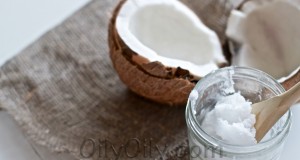
Coconut oil is famous for its nourishing and healing effect for the skin. Coconut oil soap has been known and taken advantage from for hundreds of years. If you use a soap that contains coconut oil, it can help you to fight a number of rather serious skin problems.
According to Wikipedia, coconut oil is a valuable ingredient in most of soaps because it makes the soap be harder so your bars have a longer life. Pure coconut oil soap has a mild aroma and creamy white color. It can be easily found in every beauty shop or drug store. However hand-crafted coconut oil soap has some distinctive advantages. It is made from completely natural ingredients and essential oils, so there are no chemical additives in them. It should be also taken into account that when you buy coconut oil soap from large manufacturers they contain less natural glycerin and therefore lose some of their moisturizing properties. Read also about coconut oil shampoo.
If you what to make coconut oil soap at home, be sure you are aware of all the dangers of the process of soap making. You’d better read some books on this topic or even take some classes. Nevertheless you won’t regret it as coconut oil soap is relatively easy to make and it is very fragrant, hard, and bubbly and has great moisturizing abilities.
SEE ALSO: Is Coconut Oil Alzheimer’s Hoax
Pure coconut oil soap
Ingredients
- 5 ounces of water
- 2.5 ounces of lye
- 16 ounces of coconut oil (you may buy bulk coconut oil)
RELATED: When Can We USe Fractionated Coconut Oil
Directions:
- Dress up for making soap – safety glasses, rubber gloves and a shirt with long sleeves would be fine. Prepare all required ingredients and equipment.
- Pour the lye to the water. Be careful as because of the chemical reaction the mixture will get very hot and the fumes that will occur are poisonous. Keep stirring until the lye is dissolved and then put the mixture aside to cool to approximately 105 degrees (you can measure the temperature with a candy thermometer).
- Heat the coconut oil in a stainless steel pot and softly stir with a wooden spoon until melted. Set it aside to cool to 110 degrees nearly (the coconut oil should be slightly colder than the lye mixture).
- Very slowly and carefully pour the lye mixture to the oil mixture until combined. Stir constantly either by hand or with a hand held blender until the mixture begins to saponify and gets thick. The spoon should begin to leave an apparent stirring trail in the soap mixture. If so, the mixture ‘traces’ and the key moment of the soap making process is passed.
- Pour the soap mixture into the molds which you prepared and leave in some cool and dry place for 3-5 days. Then remove the soap from the molds. Allow it to rest undisturbed for about 6 weeks for the saponification process to be completed.
- Enjoy your soap with its fragrant lather and mild moisturizing properties.
This was the recipe of pure coconut oil soap, however you can add to this formula any other oil you like. We would recommend you to try adding olive and palm oils to this recipe. The combination of these three oils which complement each other greatly will make your soap gentle and it will lather and clean fairly well as olive oil and palm oil benefit for skin too. The proportion should be as follows:
- Coconut oil –25%
- Olive oil –45%
- Palm oil – 30%
 Oilypedia.com – Benefits And Uses Of Supplemental and Essential Oils
Oilypedia.com – Benefits And Uses Of Supplemental and Essential Oils 


